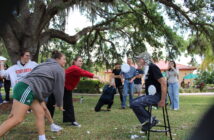“Never in history have we been more connected with others through our technology devices than today. However, even though we are much more in contact with the Internet and each other through our technology devices, in my opinion, our ability to communicate with others is actually deteriorating. Rather than having conversations in person, we are relying instead on short telegraphic communication through text and email. The ultimate effect that this has on communication patterns is negative because we are engaging in fewer and fewer conversations with those around us,” said Psychology professor, Kevin Kieffer.
Tweeting, blogging, photography, video, Snapchat and public speaking are most used today to communicate with other people all over the world. We are very good at these social media skills as we practice them daily. Face-to-face old-time communication is slowly disappearing due to the lack of practice.
“Conversation and oral communication is like any other skill — the less we use and practice it, the less effective we are at executing it. I have been teaching a course on listening skills for over 15 years now, and it seems that every new group of students I teach in this class have to work much more diligently to develop their communication skills. Communicating clearly with those around us is not something that we are inherently born with — rather, these are skills that can be — and need to be — developed over time,” said Kieffer.
How does one actually practice communicating? It seems so natural. In this modernized society it is becoming more rare every day. Effective communication consists of never talking over people, listening, noticing body language, and eye contact.
Talking over people is something that people can become commonly guilty of, if they even notice. This ties in with being a good listener. When interrupting people, one can often complete the other’s sentence. This can be interpreted as rude and disrespectful. This skill is especially important when speaking with a high authority figure.
Body language is a major aspect of non-verbal communication. One crossing his or her arm on their chest may be interpreted as disinterest or annoyance with the conversation. On the other hand, if one is using hand gestures in a calm and collected manner, it will appear that the people involved in the conversation are engaged in what is being discussed. Some people don’t use their hands when they speak, but that is okay, eye contact is another great way to achieve the same concept.
Eye contact is another major aspect of non-verbal communication. With eye contact, it shows that the people in the conversation are engaged as well as listening intently to what is being said. Maintaining eye contact throughout the conversation can serve as body language, as each person in the conversation is able to read into what the speaker is trying to say, sometimes without them actually saying what is on his or her mind.




